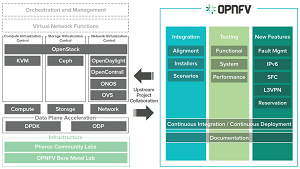News
OPNFV Project for Network Functions Virtualization Is 'Lab Ready' in Second Release
The OPNFV Project has come out with its second platform release in its continuing effort to accelerate the introduction of new network functions virtualization (NFV) products and services, now dubbing the technology as being "lab ready."
The industry group behind the open source project, which is under direction of The Linux Foundation, describes NFV as "the replacement of custom hardware running network functions by virtual servers running on a cloud platform on commercial, off-the-shelf hardware." Along with its upstart cousin, software-defined networking (SDN), the new technology approach is transforming network and application virtualization, moving from proprietary hardware-based systems to open, software-based, programmable alternatives.
The new platform release, called Brahmaputra, follows the inaugural release Arno, introduced last June. During that time, the project has seen significant growth in participation and functionality, according to Ericsson exec Chris Price, one of the leaders of the project.
With Brahmaputra, Price noted much more involvement with related "upstream" projects such as Kernel-based Virtual Machine (KVM), Open vSwitch (OVS), OpenStack, Linux kernel, OpenDaylight Project, Open Network Operating System (ONOS), Open Contrail, European Telecommunications Standards Institute (ETSI), and the Internet Engineering Task Force (IETF).
 [Click on image for larger view.]Brahmaputra Overview (source: OPNFV Project).
[Click on image for larger view.]Brahmaputra Overview (source: OPNFV Project).
"What we've seen with Brahmaputra is key stakeholders collaborating across the industry and a marked increase in community engagement overall," Price said in a blog post this week. "For example, 35 projects were involved in the Brahmaputra release, compared to just five in Arno. That's a six-fold increase in just 10 months! Even more telling is the more than 140 developers involved in the release -- which means we've seen developer participation in OPNFV as a whole increase five-fold since August of 2015."
Along with the increased collaboration and involvement comes improved functionality for the platform, which has new enhancements such as hardened features, better testing capabilities, advancements in infrastructure and testing environments, and improved deployment and integration.
"Brahmaputra demonstrates the ability to collaborate with upstream communities on feature development, address multiple technology components across the ecosystem and advance stability, performance, automation and hardened features," the project said in a news release.
Even with those improvements, the project is still in its early stages, focusing for now on testing and integration for use cases primarily concerning carriers and service provider environments, though enterprise usage is supported and more enterprise involvement is encouraged.
For now, with Brahmaputra, the technology is "lab ready," Price said, "which means it provides a viable starting point for evolving NFV use cases (such as SFC and L3VPN) and composing services in an actual lab environment. It brings improvements to platform-level testing and project infrastructure, including framework and documentation updates that set the stage for further development of the platform, but also scenarios that can be tested now."
About the Author
David Ramel is an editor and writer for Converge360.